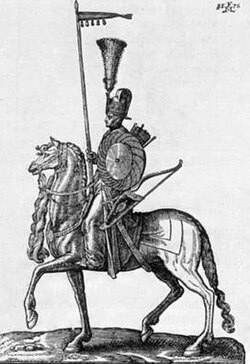
Back سباهية Arabic Sipahilər AZ سیپاهی AZB Сипаһтар BA Спахия Bulgarian Spahija BS Espahí Catalan Sipáhí Czech Spahi Danish Sipahi German
This article includes a list of general references, but it lacks sufficient corresponding inline citations. (September 2016) |
| Sipahi | |
|---|---|
| Spahiç (Balkans) | |
 A sipahi, by Melchior Lorck, 1646 | |
| Country | Ottoman Empire |
| Allegiance | Seljuk Turks and Ottoman Empire (original) |
| Branch | Cavalry |
| Equipment | Kilij, shield, lance, and bow |
| Insignia | |
| Identification symbol |  |
| Identification symbol |  |
The sipahi (Persian: سپاهی sipâhi, Turkish pronunciation: [sipaːhi]) were professional cavalrymen deployed by the Seljuk Turks and later by the Ottoman Empire.[1] Sipahi units included the land grant–holding (timar) provincial timarli sipahi, which constituted most of the army, and the salaried regular kapikulu sipahi, or palace troops. However, the irregular light cavalry akıncı ("raiders") were not considered to be sipahi. The sipahi formed their own distinctive social classes and were rivals to the janissaries, the elite infantry corps of the sultans.
A variant of the term "sipahi" was also applied by colonial authorities to several cavalry units serving in the French and Italian colonial armies during the 19th and 20th centuries (see Spahi).[2]
- ^ Zaporozhets, V. V. The Seljuks. Hannover (2012). Translated by K.A. Nazarévskaia. p. 10
- ^
For example:
"Spahis réguliers, en Afrique". Table générale analytique des matières inseréees au Journal militaire, Du 1er janvier 1834 au 21 décembre 1839 (in French). Paris: Magimel, Anselin et Pochard. 1840. p. 267. Retrieved 28 July 2023.
1834[,] 10 sept. Ordonnance du Roi qui prescrit la formation à Alger d'un corps de cavalerie indigène sous la dénomination de spahis réguliers.